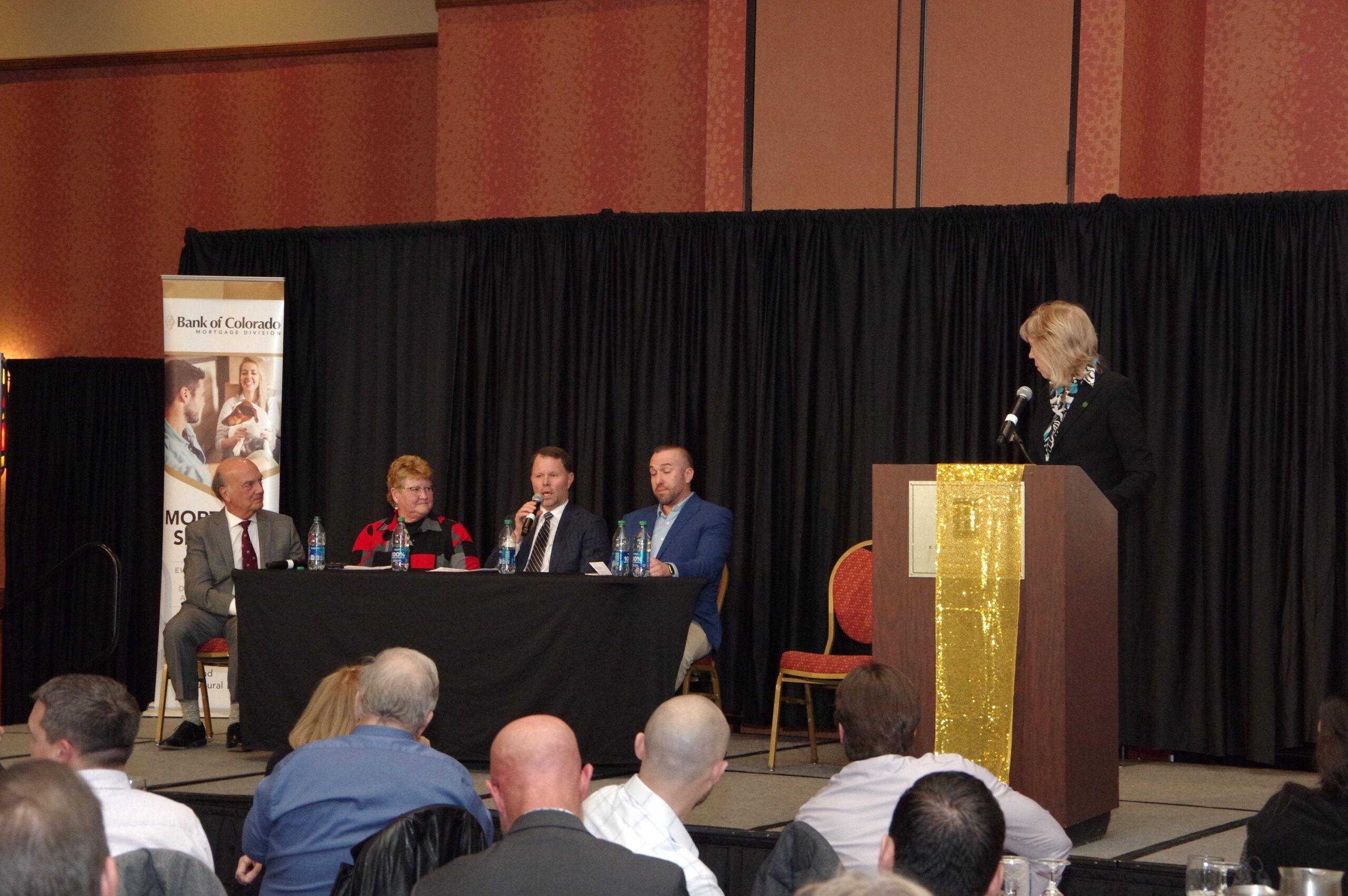Economic forecast sees less talk of recession

LOVELAND — Although post-pandemic challenges remain in several business sectors, a leading economist and leaders in banking, real estate and health care also cited some positive trends for 2024 on Wednesday at BizWest’s Northern Colorado Economic Forecast event at the Embassy Suites conference center in Loveland.
“We’re starting to see fewer people saying, ‘Oh, there’s a recession on the horizon.’ The question is only whether there’ll be a soft landing,” said Richard Wobbekind, senior economist and faculty director of the Business Research Division at the University of Colorado Boulder’s Leeds School of Business, noting that in 2023 “the economy was certainly more resilient than we thought it was going to be,” especially in terms of gross domestic product.
“If there is a soft landing, what we think is that we would have very slow growth for at least the second and third quarters of the year, down around 1% or less than 1% GDP growth. That’s sort of our baseline forecast,” Wobbekind said. “There are other major financial firms who are suggesting we’re going to have a second- and third-quarter, very, very mild recession. The difference would be very, very little, other than the psyche of what it might mean to consumers if they hear they’re in a recession, but I think in terms of spending power, there’s not really much behind that.”
SPONSORED CONTENT
Citing a prolonged period of mixed signals on the economy — “some things are going up in terms of debt, some things are going sideways in terms of confidence” — Wobbekind acknowledged that “we haven’t seen the kind of improvement that we might have hoped for. But we have had very strong GDP performance, and I think 2023 will close out, when the data comes in, at about 2.3% for the year. There was nobody that I saw forecasting anything above 1.2% for GDP last year. So this was a fairly remarkable performance.”
However, he cited a list of uncertainties as the economy continues to emerge from the COVID-19 restrictions.
“Working from home, it’s helped us in terms of retaining employees, but this puts a lot of concern because we don’t know exactly how that’s going to play out, and that’s had a very strong impact on commercial real estate prices and how severe that might be or might not be in terms of the refinancing of commercial real estate,” he said. ”In particular, we’re talking about office space.”
Still, pointed out Jake Hallauer, president of the NAI Affinity real-estate firm, “Northern Colorado has never been a huge office market.” Office space in Larimer and Weld counties totals around 18 million square feet, he said, slightly more than half of the 35 million square feet in the retail market and 52 million to 53 million square feet of industrial space.”
“Here and in other parts of Colorado, industrial space is doing extremely well,” Wobbekind said. “I think there’s a continuing demand for most product types,” Hallauer said, and Cody Fullmer, Northern Colorado market president for Bank of Colorado, added that “I see 2024 to be very productive.” The major hurdle he noted for all construction projects, however, is getting them through the municipal and county permitting process. “That takes, in some cases, so long,” he said, “that by the time they get approved, they’re in a different year.”
How much investment and construction improves this year will be determined by what the Federal Reserve does with interest rates, Wobbekind said.
“I think the Fed has to take a slow look at this and not start cutting rates really soon,” he said. “I don’t think they will. I think they’ll let things stay flat and settle.”
If the Fed does reduce rates in 2024, Fullmer said, “we should continue to see a bolster to the economy, allowing for some of the opportunities that have kind of been sidelined during 2023 to probably start up again.
“I do think the Fed is going to lower rates,” he said, predicting a one- to one-and-a-half-point reduction by the end of the year. “If we see that reduction, we’re going to see lower operating lines of credit; interest rates are going to go down on those types of loans.”
Homebuyers are seeing around 6.5% interest on 30-year mortgage loans, Fullmer said, and “if we can get down to 5%, I believe that we’ll see a lot of activity.”
Bank of Colorado is keeping a close eye on “the maturity in our portfolio,” Fullmer said. “During 2020-22, we repriced so much of our portfolio into mostly five-year fixed rates. So if those were done in 2022, say, that five-year rate is not going to change until 2027. With the reduction, businesses are going to see lower operating costs, but they’re also tied in long-term on the long-term investments. That’s going to be very good for Fort Collins and Northern Colorado.”
Part of what Wobbekind called the nation’s “remarkable” recovery has been “how positive the job growth has been. Last year was the second highest year for job growth in history,” he said, “only surpassed by 2022 when we came out of the recession.
“There were 4 million new jobs last year,” he said, “but of those jobs, 76% were in health care, government, and leisure and hospitality. For the last six months, over 90% were in those three sectors. We’re starting to see less and less hiring in professional business services, tech jobs, mining and natural resources, construction — those areas are becoming much less significant in terms of overall U.S. job growth.
“In retail, basically we’re at the same place we were before the recession started,” Wobbekind said. “Our highest rate of job growth has been in office-related jobs. Yet we have these issues with open office space in downtown areas. We need to figure out where this plays out at the end of the day in terms of use of commercial space and reallocation of resources.”
He noted that 2023 saw two available jobs in the United States for every unemployed person. “Now, that number’s down to 1.4, so that’s a closing of the gap,” he said. “We see the hiring going down, but we also see the quits going down; people aren’t leaving their jobs as readily, which is an indication that basically the job environment is getting a little bit tighter.”
In Colorado, he noted, “our labor force is tighter than the nation as a whole.” He added that while visiting Durango recently, he had spotted a bumper sticker that said “Colorado is full. I hear Kansas is nice.”
“We’ve never had this much employment in the state,” he said. He predicted overall higher employment in the region than in pre-COVID times, but noted that it would be more concentrated in the Fort Collins-Loveland metropolitan statistical area.
Although construction has been slower in Colorado than in the nation as a whole, Wobbekind said, “we’re forecasting a slight uptick.” He said net farming income is “coming up” as well, “but not as high as it was in 2021 or 2022.” He predicted “pretty consistent pricing” for natural resources and mining,”
Hallauer said the “investment market has slowed dramatically” but that there is “still a lot of interest and demand in the commercial real estate investment market. There’s not a lot of good assets to buy. Demand is basically outweighing supply.
“I do expect to see additional demand for housing in our region,” he said. “Land-transaction volume, I would hope, would bounce back this year.”
One of the hardest-hit sectors during COVID and beyond has been health care, said Marilyn Schock, president of UCHealth’s Greeley Hospital, which opened seven months before the pandemic-related shutdown.
“Margins for hospitals are at historic lows,” she said, noting that according to the Colorado Hospital Association, more than 70% of Colorado hospitals have an unsustainable operating margin, up from 50% before the pandemic.
“Costs are outpacing reimbursements,” she said. “For most hospitals, patient revenue is not covering the cost of the patient. We continue to see reimbursement being ratcheted down, but costs are going up.”
The sector has been hit by the triple whammy of nurses and other health care professionals leaving their jobs, the soaring costs of technology and the impact of new legislation, Schock said.
Citing the state’s 368 new health-care laws, including 19 major health care reform bills, Schock said that “requires hospitals to hire dozens of people who are focused on compliance with the new regulations” — and those hires are full-time positions.
“When you build a hospital room, because of everything that has to go into it, all of the services that have to support it, it’s well over $1 million, a million and a half,” Schock said. “So bricks and mortar are not something that you just put up.”
Because of those expenses and the climbing costs of labor, she said, “you’re going to see hospital closures, you’re going to see consolidation, farther distance to go for care.”
Part of the answer will be cost savings through technology, Schock said.
“It used to be, with a heart valve replacement, people were in the hospital for four to six weeks,” she said. “Today, with the new technology, 48 hours might be pushing it.”

